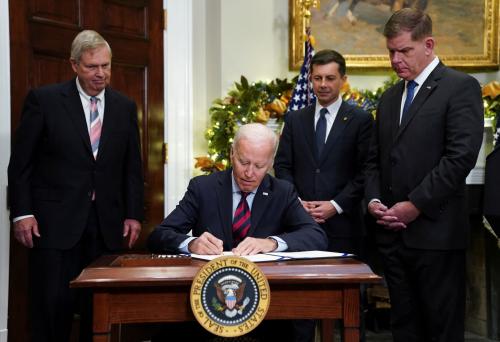In 2014, the Commodities Futures Trading Commission (CFTC) issued a no-action letter to PredictIt, a market where individuals can make trades on their predictions of future political and economic events. No-action letters like this are issued by staff in some federal regulatory agencies to memorialize the staff’s view that a certain set of facts submitted by the regulated entity would not violate agency rules. In this case, the no-action letter concluded by saying CFTC staff reviewing PredictIt’s application “will not recommend that the Commission take any enforcement action”1 for PredictIt’s failure to register with the CFTC as a designated contract market provided that PredictIt abided by a series of conditions outlined in the letter. This letter distinguished PredictIt from previous prediction markets such as Intrade, which were sued by the CFTC for failing to abide by the agency’s rules. The PredictIt letter noted that the staff’s position was subject to change and did not bind the full CFTC. These caveats notwithstanding, the letter gave stakeholders sufficient comfort to allow PredictIt to flourish as one of the only reputable, real-money political prediction markets.
In August 2022 the CFTC staff withdrew the 2014 no-action letter and ordered PredictIt to cease operations within approximately six months. The CFTC asserted that PredictIt had not complied with the original terms of the letter and verbally discussed the issues with the recipient, arguing that PredictIt was effectively operated by a for-profit entity and offered trade contracts beyond political and economic events (such as whether an accused lion poacher would be extradited to Zimbabwe). However, the CFTC did not provide these details in the revocation letter. Supporters of the market sued. Breaking from the approach taken by other federal appeals courts, the U.S. Court of Appeals for the Fifth Circuit granted PredictIt supporters’ request in Clarke v. CFTC to stop the CFTC from withdrawing the no-action letter. If the Fifth Circuit’s approach were applied by other courts (including the Supreme Court), it would mark a major change in the law governing agency no-action programs.
This piece analyzes the Fifth Circuit’s decision and explains why it may have widespread implications in agencies well beyond the CFTC. In doing so, it gives a broader view of the role of no-action letters in the regulatory regime and explains why the court’s ruling threatens to disrupt the current arrangement that has provided extraordinary benefits to regulated entities.
The decision will push agencies to discard or curtail their no-action letter programs. But doing so would harm regulated entities the most. No-action letters are often the “grease” that makes administrative programs work, akin to an administrative handshake rather than a binding contract. If agencies were to pull away from these arrangements, navigating regulatory requirements could become more fraught for regulated firms.
The Fifth Circuit’s decision
The Fifth Circuit’s decision is noteworthy for several reasons. The first is that the judges found they had jurisdiction to consider the challenge at all. Citing prior appeals court decisions, the CFTC argued that the no-action letter was a discretionary and non-binding staff action that was not reviewable by the courts. The Fifth Circuit held that despite these CFTC caveats, the no-action letter was functionally equivalent to a “license” (or permission to operate) under the Administrative Procedure Act (APA) because it effectively allowed PredictIt to operate.
In reaching this conclusion, the court emphasized that binding CFTC rules governing the agency’s no-action letters state that recipients can “rely” on letters issued pursuant to the rules.2 The Fifth Circuit said that the CFTC procedural rule underlying the no-action letter “suggests that the CFTC has withdrawn its discretion to bring enforcement proceedings against the holder of a no-action letter, which undermines the contention that the CFTC is in no way bound through no-action letters.” And because PredictIt had no administrative avenue to appeal, staff withdrawal of the letter was reviewable even though it lacked full CFTC endorsement. Finally, because the CFTC’s August 2022 withdrawal letter contained little explanation, the Court found that it was arbitrary and capricious under the APA. The Court dismissed a subsequent CFTC staff letter with additional explanation as an invalid post-hoc rationalization. Presumably, a decision by the full CFTC (a new decisionmaker distinct from CFTC staff) would not be similarly dismissed.
Possible implications of decision
The Fifth Circuit’s opinion represents an important change to the law that could have far-reaching implications for agencies such as the Consumer Financial Protection Bureau, the Securities and Exchange Commission, the Department of Justice, and others that issue no-action letters. As an initial matter, the panel in Clarke acknowledges that its opinion breaks with the longstanding positions of at least four other circuit courts of appeals, which have for decades taken a contrary position.
Substantively, it would mean these letters will now work as a one-way ratchet, making it easy for agency staff rather than an agency itself to effectuate policy and very difficult for the agency itself to undo those staff decisions. The opinion effectively allows agency staff to create binding policy through staff no-action letters (in this case, binding licenses to operate under CFTC rules) because no-action letters can be issued by staff but only rescinded by the entire agency in compliance with APA procedures such as notice-and-comment or an adjudicatory hearing. This is at odds with recent Supreme Court decisions emphasizing the constitutional importance of presidentially accountable appointees making policy decisions. It also cannot be reconciled with the notion that policy should be made in a transparent and accountable manner through processes such as notice-and-comment rulemaking or adjudication with procedures that meet statutory requirements.
This accountability problem is likely to be even worse at multimember agencies, where agency staff typically report to the commissioner or board chair rather than all commissioners or board members. Because the agency’s chair can direct the staff with respect to no-action letters, the Clarke decision could empower agency chairs at the expense of other members, upsetting the balance of power within the agency. This could be an important issue for agencies like the Securities and Exchange Commission (SEC) that issue a significant volume of no-action letters. The agency chair might be checked by colleagues insisting that the chair cease issuing no-action letters without their informal approval, in exchange for votes on important rules or enforcement cases. But that is hardly a dynamic to wish for.
The decision will likely have far-reaching consequences that harm regulated entities.
The decision also creates an important asymmetry between regulation and deregulation. Because no-action letters typically grant regulatory relief, the logic of Clarke effectively allows deregulation to occur via staff letters while still requiring regulatory policy efforts to comply with procedural requirements such as notice-and-comment rulemaking. The decision will accordingly incentivize agencies with deregulatory priorities to issue no-action letters to make their views costly to change.
But the Biden administration is not likely to sit idly by as these threats mount. The administration and its agencies may respond in three predictable ways, assuming that the current ruling is not overturned by the full Fifth Circuit or the Supreme Court.
First, some agencies may simply eliminate no-action programs entirely. A primary benefit of no-action letter programs is that they are a relatively straightforward and low-stakes manner of facilitating market actions. Clarke significantly changes that calculus, and certain agencies may simply conclude that the risks do not warrant maintaining the programs.
Second, agencies may rescind rules like the CFTC rule at issue in Clarke, which allows recipients to “rely” on the staff views expressed in their no-action letters. Instead, agencies might even require recipients to affirmatively acknowledge that no-action letters are non-binding staff views that are subject to change and that reliance is at the recipient’s own risk. This change would devalue no-action letters at most agencies relative to their current somewhat ambiguous status. Even if agencies led by a future administration reversed changes along these lines, the result could be a whiplash that undermines the ability of regulated entities to rely over the long term on no-action letters, which is their primary purpose.
Third, agencies may provide shorter and less detailed no-action letters. In the 2014 PredictIt approval letter,3 the CFTC analyzed the applicant’s facts and circumstances and based approval on conditions such as capping investment and trading volumes, being operated by a nonprofit institution, and sharing the data with researchers. In light of the facts and these conditions, the staff issuing the letter concluded that it “does not believe that operation of this proposed market … would be contrary to the public interest.” Because such analysis and conclusions may be more likely to be interpreted by a court as a licensing grant, the CFTC may change its approach and instead simply recite the facts presented and provide a brief approval. A letter along these lines could read “based on the facts presented, the staff would not recommend that the Commission take enforcement action” followed by the caveats that the views expressed are subject to change and do not bind the whole agency. Indeed, the SEC (an important and frequent no-action letter issuer) already provides some no-action letters along these lines.
These changes would reduce the value of no-action letters, which in turn would most hurt regulated entities. Take the CFPB as an example. In 2016 under Obama-era leadership, the CFPB created a relatively narrow no-action letter program. Letters issued under the program were subject to change at the CFPB staff’s discretion and were not binding on the CFPB’s director. In 2019, the Trump-era CFPB significantly altered the program to make no-action letters more useful for their recipients. The new policy stated that the CFPB as a whole (not just the staff) believes that no-action letter recipients “should be able to reasonably rely on any Bureau commitments made in the letter” and that “[t]he Bureau expects termination of a No-Action Letter to be quite rare.” Under the Biden administration, the CFPB eliminated its no-action program entirely. The Clarke decision may push other agencies to do the same.
Conclusions
At first glance, the Fifth Circuit’s decision in Clarke to review and invalidate the CFTC’s withdrawal of PredictIt’s no-action letter appears to be a victory for regulated entities. In reality, it is anything but. The decision will likely have far-reaching implications that harm regulated entities. Agencies will have every incentive to respond by: 1) issuing fewer no-action letters and, 2) including less analysis and more disclaimers in those letters that are issued. This would most harm regulated entities, which rely on no-action letters to memorialize a mutual understanding of how the law applies to their often ambiguous situation in an environment where agency personnel change frequently. If agencies were to pull away from these arrangements, navigating regulatory requirements could become much more fraught for regulated firms.
-
Acknowledgements and disclosures
Connor Raso is Acting Deputy General Counsel at the Public Company Accounting Oversight Board. The views expressed here reflect only those of the author.
The author did not receive any financial support from any firm or person for this article or from any firm or person with a financial or political interest in this article. He is currently not an officer, director, or board member of any organization with an interest in this article.
-
Footnotes
- Download the letter with this link https://www.cftc.gov/csl/14-130/download
- The court’s decision was on whether to stop the CFTC’s withdrawal of the letter and it may consider the merits of the matter again if the CFTC continues the case.
- Download the approval letter here https://www.cftc.gov/csl/14-130/download
The Brookings Institution is committed to quality, independence, and impact.
We are supported by a diverse array of funders. In line with our values and policies, each Brookings publication represents the sole views of its author(s).







Commentary
How betting platform PredictIt’s legal struggle could hamper regulators and hurt regulated firms
September 21, 2023